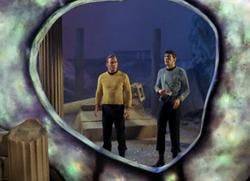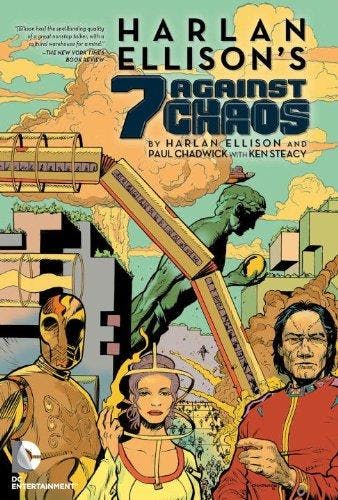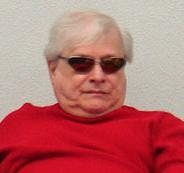Published Jul 8, 2013
EXCLUSIVE: Star Trek Legend Harlan Ellison, Part 1
EXCLUSIVE: Star Trek Legend Harlan Ellison, Part 1


Cut to last September. StarTrek.com ran into Ellison at Walter Koenig’s Star Ceremony and asked Ellison if he might consider an interview. Ellison said he’d think about it, and we chose not to push our luck. Then, surprisingly, the phone rang. Ellison himself offered to do an interview if we’d arrange for him to get a copy of his hysterical and potty-mouthed roast speech from the Koenig festivities. We made it happen and then decided to wait to talk to Ellison until the release of his latest book, 7 Against Chaos, a graphic novel which he collaborated on with Paul Chadwick and Ken Steacy. DC Entertainment will release 7 Against Chaos in comic stores on July 10 and on July 16 in print and e-book. And, sure enough, Ellison held up his end of the deal, spending the better part of a half-hour charming, cursing and curmudgeon-ing his way through a wide-ranging interview. Below is part one, and visit StarTrek.com again tomorrow to check out part two.
STARTREK.COM: How long was 7 Against Chaos in the works?
ELLISON: Twenty years. Twenty years.
STARTREK.COM: Why so long?
ELLISON: Well, I love Kurosawa’s The Seven Samurai and, by extension, the remake, The Magnificent Seven. They are two of my favorite films of all time. I always felt, “Wouldn’t it be great to do The Seven Samurai in space?” I was approached by many different film companies, 20 years ago, to do a lot of different films. They would always say, “Well, what do you have?” I would say, “Let’s do The Seven Samurai in space.” Well, they didn’t have the SFX at the time. They just didn’t have the special effects and it would have cost them many, many, many millions of dollars to do. So I had to put it on the backburner for a little while. Then I was approached by one of the animation houses. I can’t remember which one now. I told them the story and they liked it, and I did a précis, a bible of the original story. Then one thing or another happened and it fell between the stools. Circumstance happens, as they say. Then it sat for 10 years.

STARTREK.COM: That’s when you were approached by Dan DiDio at DC…
ELLISON: He was the head honcho there, and he said, “Do you have something big for an arc that we can do?” Dan wanted me to do a Justice League or a Justice Society. I said, “Well, I’ve got this great idea for The Seven Samurai in space,” and Dan said, “Tell me more.” So Dan DiDio was the midwife of this project. That was 10 years ago. On the phone we had a long conversation. It went on for the better part of an hour. He said, “Who do you want to draw it?” I had my choice of anybody. Anybody. I said, “I want Paul Chadwick,” who, of course, is the creator of Concrete and had done any number of pieces with me. I’m in love with Paul’s work. If I was Athos, then Paul became Porthos. Dan said, “Who do you want to color it?” Paul and I both wanted Ken Steacy. Ken had done my graphic novel Night and the Enemy and had done illustrations for any number of pieces of my work. Ken, in my mind, is one of the three finest colorists the industry has ever produced. So the three of us became Athos, Porthos and Aramis, and it was a three-headed conglomerate from the very start.
STARTREK.COM: Take us through the process. Did the words inspire the art and vice-versa, or did each of you do your own thing?
ELLISON: Well, once it left my hands, I left the boys alone. Each in his own way is an artisan of the first order. So, for me to direct them too much is not right. The only times I would direct them from what they handed me back was when the nuance – it was always never more than a nuance… when the tilt of the compass was maybe a fraction off. What I did was I wrote the whole script, with all the dialogue. Parts I left unsaid, and I’d say to Paul, “You need dialogue here. Fill it in yourself,” because Paul is as good a writer as he has ever been. So I trusted him implicitly. That’s the cornerstone of this project, an absolute, unflagging faith in each other’s talents and the height of each other’s talents. We all three respect each other as equals, not peers, and that’s very important to put down.
I would send it off to Paul, and Paul would do the pencils. Paul would send me the pencils and I would make any minor – underline that… minor – corrections and then send it back to him. Paul would do the inks. I would look again. If there was any small thing that had escaped our notice, I would note it. He would do it and then send it on to DC and DC would then send them on to Kenny, and Kenny would bring his own palette to it. Kenny works up north, and he’d send me from time to time 10 or 20 pages. I would say, “Maybe this this looks a little too pastel. Maybe you want to shade it a little,” and he might or might not (agree and make changes).

STARTREK.COM: But it’s still 10 years between DiDio giving you the go-ahead and the imminent release of the book. What took so long?
ELLISON: It took so long because our editor at the beginning was a guy named Peter Tomasi, who’s a dynamite editor and a dynamite writer. Peter, after being an editor at DC for a number of years, decided to go freelance. When he did, they handed us off. Dan DiDio had moved out to Hollywood. So there were a lot of people at DC who were, I’m sure, perfectly competent… They issue five million books a day and were perfectly competent for everything, but for a project like this, which had special needs and operates on half a dozen different levels, they let us slide. It wasn’t their top priority, the way it had been Dan DiDio’s. So they handed us off to half a dozen different editors, among whom, and I shall name no names, were overload or incompetent, I don’t know which. It comes out of the same place. One of them lost 30 pages of Paul Chadwick art for four years. Finally, Paul had to re-do them. I had the pencil sketches, so I was able to send him the pencil sketches again so that he could reproduce them. It was painstaking work. They paid us very, very handsomely all along the way and I retained all the rights, all the rights, even the film rights. We’ve already had half a dozen nibbles for giant panorama films. Warner Bros. is one of the ones bidding.
Finally, after 10 years, Bobbie Chase became our editor, and she’s just done a wonderful, wonderful job of hauling everything together. I talked to the people at the PR companies. There’s a separate person who puts together the ads. We just learned that there’s a full-page ad for 7 Against Chaos in damn near every DC Comic that came out last week. So we’ve got the message out there.
STARTREK.COM: The logline is deceptively simple: Seven unique and powerful warriors are brought together to save Earth. To your thinking, what’s the story beneath the story?
ELLISON: What is the story under the story? Well, nobody has asked me that in that specific way. The sense of it is that there is a quality that runs among all of us, which is a sense of responsibility. I think that’s the underlying motif, responsibility, one to one, one to all, like me to Ken to Paul. And, in the story, you’ll see that it’s not just your mock-up, phony, TV wannabe Mission: Impossible gang, where they gather four or five or six disparate characters, each of whom has a quirk or comes from a different country, and throw them together on bogus missions. This is a mission that lies at the core of the future of all species, and their sense of responsibility is first to the basic, core idea of survival and then responsibility to the unit and then to themselves individually.
Visit StarTrek.com again tomorrow to read part two of our exclusive interview with Harlan Ellison. In it, he discusses life, dying, Star Trek and more!
